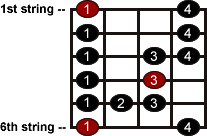Learn Guitar Scales - Easy Scales for Guitar
Blues scale |
Minor scale |
Minor pentatonic |
 |
 |
 |
| Major pentatonic | ||
 |
Most Western music divides the musical octave (when one note is twice as high as another) into 12 sections, called semitones. On the guitar, each semitone is represented by a fret. Scales start and stop on the octave, and the most common scales (Major and Minor) consists of seven different notes, other scales may use more or less than seven notes.
It is important to remember that on the guitar, if you know the pattern of a particular scale, you can move that pattern anywhere else on the fret board and be playing in a different key. By this, I mean if you are playing a major scale, beginning on the low E string at the fifth fret, which is an A note and then you played the same pattern of notes, but you started on the 3rd fret of the low E string, you will be playing a G major scale. If this sounds confusing to you, read the entire article, and if it is still unclear, see the musical scale article on Wikipedia or the Music Theory wikibook.
There are many different scales: the major scale, three different forms of the minor scale, the blues scale, the pentatonic scale, the whole tone scale, the diminished scale and some scales that originated in Spain and India. There are also very interesting scales from eastern music. It is possible to create your own scales by altering another as you wish, or completely coming up with your own.
The "Circle of Fifths" is a memory aid for learning the major and minor scales which can equally be applied to all scales. The scales in common use have evolved over many centuries and the established major scale, followed by the natural minor and then the two variants: the harmonic minor scale and the melodic minor scale form the basis of Western music. The "Circle of Fifths" and major scales in tab can be found in the Scale Manual section of this book.
All scales in this section are tabbed out for the key of A, meaning that the root note of the scale is on the 5th fret of the low E string. Starting the scale here provides lots of room up and down the neck to play, and helps you learn to make connections between different scale shapes.
The Major and Minor pentatonic scales are the simplest and most used in rock,blues and country music and are the starting blocks for learning lead soloing techniques.
